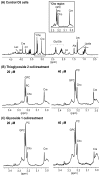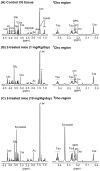The effect of antitumor glycosides on glioma cells and tissues as studied by proton HR-MAS NMR spectroscopy
- PMID: 24194925
- PMCID: PMC3806797
- DOI: 10.1371/journal.pone.0078391
The effect of antitumor glycosides on glioma cells and tissues as studied by proton HR-MAS NMR spectroscopy
Abstract
The effect of the treatment with glycolipid derivatives on the metabolic profile of intact glioma cells and tumor tissues, investigated using proton high resolution magic angle spinning ((1)H HR-MAS) nuclear magnetic resonance (NMR) spectroscopy, is reported here. Two compounds were used, a glycoside and its thioglycoside analogue, both showing anti-proliferative activity on glioma C6 cell cultures; however, only the thioglycoside exhibited antitumor activity in vivo. At the drug concentrations showing anti-proliferative activity in cell culture (20 and 40 µM), significant increases in choline containing metabolites were observed in the (1)H NMR spectra of the same intact cells. In vivo experiments in nude mice bearing tumors derived from implanted C6 glioma cells, showed that reduction of tumor volume was associated with significant changes in the metabolic profile of the same intact tumor tissues; and were similar to those observed in cell culture. Specifically, the activity of the compounds is mainly associated with an increase in choline and phosphocholine, in both the cell cultures and tumoral tissues. Taurine, a metabolite that has been considered a biomarker of apoptosis, correlated with the reduction of tumor volume. Thus, the results indicate that the mode of action of the glycoside involves, at least in part, alteration of phospholipid metabolism, resulting in cell death.
Conflict of interest statement
Figures





Similar articles
-
Metabolite changes in BT4C rat gliomas undergoing ganciclovir-thymidine kinase gene therapy-induced programmed cell death as studied by 1H NMR spectroscopy in vivo, ex vivo, and in vitro.J Biol Chem. 2003 Nov 14;278(46):45915-23. doi: 10.1074/jbc.M306209200. Epub 2003 Sep 3. J Biol Chem. 2003. PMID: 12954643
-
In vivo, ex vivo, and in vitro one- and two-dimensional nuclear magnetic resonance spectroscopy of an intracerebral glioma in rat brain: assignment of resonances.J Neurochem. 1994 Jan;62(1):166-79. doi: 10.1046/j.1471-4159.1994.62010166.x. J Neurochem. 1994. PMID: 8263516
-
High-resolution magic-angle-spinning 1H NMR spectroscopy reveals different responses in choline-containing metabolites upon gene therapy-induced programmed cell death in rat brain glioma.NMR Biomed. 2005 Jun;18(4):252-9. doi: 10.1002/nbm.955. NMR Biomed. 2005. PMID: 15884096
-
Effects of Doxorubicin, Cisplatin, and Tamoxifen on the Metabolic Profile of Human Breast Cancer MCF-7 Cells As Determined by 1H High-Resolution Magic Angle Spinning Nuclear Magnetic Resonance.Biochemistry. 2017 Apr 25;56(16):2219-2224. doi: 10.1021/acs.biochem.7b00015. Epub 2017 Apr 12. Biochemistry. 2017. PMID: 28379688
-
[Progress in nuclear magnetic resonance spectroscopy for early cancer diagnosis].Guang Pu Xue Yu Guang Pu Fen Xi. 2008 Aug;28(8):1942-50. Guang Pu Xue Yu Guang Pu Fen Xi. 2008. PMID: 18975839 Review. Chinese.
Cited by
-
Focus on the glycerophosphocholine pathway in choline phospholipid metabolism of cancer.NMR Biomed. 2019 Oct;32(10):e4112. doi: 10.1002/nbm.4112. Epub 2019 Jun 11. NMR Biomed. 2019. PMID: 31184789 Free PMC article. Review.
-
Expression of Tim4 in Glioma and its Regulatory Role in LN-18 Glioma Cells.Med Sci Monit. 2016 Jan 7;22:77-82. doi: 10.12659/msm.894963. Med Sci Monit. 2016. PMID: 26741116 Free PMC article.
-
Evaluation of Cancer Metabolomics Using ex vivo High Resolution Magic Angle Spinning (HRMAS) Magnetic Resonance Spectroscopy (MRS).Metabolites. 2016 Mar 22;6(1):11. doi: 10.3390/metabo6010011. Metabolites. 2016. PMID: 27011205 Free PMC article. Review.
-
Magnetic Resonance (MR) Metabolic Imaging in Glioma.Brain Pathol. 2015 Nov;25(6):769-80. doi: 10.1111/bpa.12310. Brain Pathol. 2015. PMID: 26526945 Free PMC article. Review.
-
Applications of high-resolution magic angle spinning MRS in biomedical studies I-cell line and animal models.NMR Biomed. 2017 Jun;30(6):10.1002/nbm.3700. doi: 10.1002/nbm.3700. Epub 2017 Mar 16. NMR Biomed. 2017. PMID: 28301071 Free PMC article. Review.
References
-
- Lindon JC, Beckonert OP, Holmes E, Nicholson JC (2009) High resolution magic angle spinning NMR spectroscopy: Application to biomedical studies. Prog NMR Spectrosc 55: 79–100. doi:10.1016/j.pnmrs.2008.11.004. - DOI
-
- Sitter B, Bathen T, Tessem M, Gribbestad I (2009) High resolution magic angle spinning (HR MAS) MR spectroscopy in metabolic characterization of human cancer. Prog NMR Spectrosc 54: 239–254. doi:10.1016/j.pnmrs.2008.10.001. - DOI
Publication types
MeSH terms
Substances
LinkOut - more resources
Full Text Sources
Other Literature Sources

